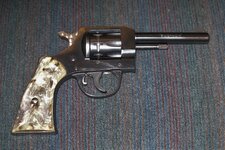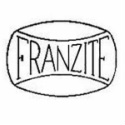This is a cute little Harrington & Richardson "Sidekick" Model 929, caliber 22. Nine shot cylinder, double action. The serial number prefix indicates this one was made in 1956, which I believe was the first year this model was sold. The barrel configurations changed over the years but this one has a dainty barrel. Back when this revolver was made, it was made the same way a Colt Python of the same era was made -- hand fit and finished. Big difference in price; this H&R sold for about $40 in 1956; the Python was introduced in 1955 and sold for $125. Obviously they were not competing in the same market. The Colt Official Police in .22 was about $70. All of these prices were back when money was worth a lot more and harder to get. The median annual income for men was $3,600 in 1956.
My cousin Rich turned 21 in 1957 and he wanted to buy a handgun right away. He bought a new Ruger .22 automatic, what we call a Mark now. I think he said it cost $37.50.
Anyway, the little H&R is in excellent condition. It has been fired, but appears not to have seen much use. There is no wear on the original finish. The action is smooth and in perfect time. The Franzite grips with the bogus marbled look at original for this gun; many such were made with this same design in the middle 1950's. Note the engine turning on the hammer.
After disposing of 75% of my guns a few years ago, lately I've been buying several more. The "assault" weapon ban in Wash. has convinced me that it isn't necessary for me to buy fancy guns to have fun with. This little H&R revolver only cost $275 and I'm sure that my grandson and I will get that much fun out of it. He and I have also taken up basic trap shooting using inexpensive shotguns. He got the knack of it right away.

My cousin Rich turned 21 in 1957 and he wanted to buy a handgun right away. He bought a new Ruger .22 automatic, what we call a Mark now. I think he said it cost $37.50.
Anyway, the little H&R is in excellent condition. It has been fired, but appears not to have seen much use. There is no wear on the original finish. The action is smooth and in perfect time. The Franzite grips with the bogus marbled look at original for this gun; many such were made with this same design in the middle 1950's. Note the engine turning on the hammer.
After disposing of 75% of my guns a few years ago, lately I've been buying several more. The "assault" weapon ban in Wash. has convinced me that it isn't necessary for me to buy fancy guns to have fun with. This little H&R revolver only cost $275 and I'm sure that my grandson and I will get that much fun out of it. He and I have also taken up basic trap shooting using inexpensive shotguns. He got the knack of it right away.













